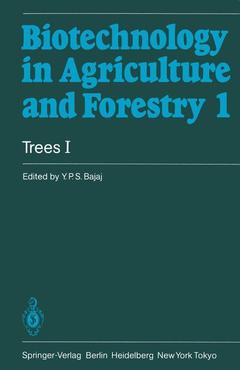Trees I, Softcover reprint of the original 1st ed. 1986 Biotechnology in Agriculture and Forestry Series, Vol. 1
Langue : Anglais

Biotechnology has come to a stage where, by replacing some of the age old practices of breeding, it can produce novel and improved plants and animals that can better serve human beings and their purposes. The techniques of cellular and subcellular engineering, such as gene splicing and recombinant DNA, cloning, hybridomas and monoclonal anti bodies, production of human insulin, protein engineering, industrial fermentation, artificial insemination, cryopreservation and ovum trans fer, plant tissue culture and somatic hybridization, nitrogen fixation, phytomass production for biofuels etc have advanced greatly in the past decade, due to the availability of better equipment and the consolida tion of knowledge. Product orientation has removed biotechnology from the area of pure academic interest to one of utility where the final product is a spur to action. Businesses have started pouring money into projects, which has aided greatly in improving equipment, information exchange, and arousing the interest and imagination of the public. The common goal of science, industry and the public opens wide vistas and great hopes for biotechnology. The business of biotechnology addresses itself to issues of factory farming, technology transfer, joint ventures, international cooperation and to specific topics as well as the produc tion of diagnostic kits. Industry is particularly concerned with the phar maceutical field and microbial biotechnology from which profitable return§ can accrue. Commercial interests have led to better management practices and systematisation.
I Biotechnology of Tree Improvement for Rapid Propagation and Biomass Energy Production.- II Virus-Free Trees Through Tissue Culture.- III Micrografting and its Applications to Tree Improvement.- IV Induction of Rooting.- V Induction of Haploids.- VI Tissue Culture of Alnus spp. with Regards to Symbioses.- VII Preservation of Fruit Tree Pollen.- VIII Cryopreservation of Germplasm of Woody Plants.- IX Fruit Trees.- 1. Plum (Prunus domestica).- 2. Cherry (Prunus avium L.).- 3. Peach (Prunus persica L. Batsch).- 4. Apple (Malus × domestica Borkh.).- 5. Pear (Pyrus communis).- 6. Citrus (Citrus species).- 7. Papaya (Carica papaya L.).- 8. Banana (Musa spp.).- 9. Olive (Olea europaea L.).- 10. Mango (Mangifera indica L.).- X Forest and Nut Trees.- 1. Radiata Pine (Pinus radiata D. Don).- 2. Norway Spruce (Picea abies L.).- 3. Araucaria (Araucaria spp.).- 4. Cryptomeria (Cryptomeria japonica Don.).- 5. Juniper (Juniperus polycarpos C. Koch).- 6. Elms (Ulmus spp.).- 7. Eucalypts (Eucalyptus spp.).- 8. Sandalwood (Santalum album L.).- 9. Acacia (Acacia koa Gray).- 10. Mulberry (Morus alba L.).- 11. Chestnut (Castanea spp.).- 12. Almonds (Prunus dulcis (Miller) D. A. Webb).- 13. Coconut Palm (Cocos nucifera L.).- References.
Date de parution : 11-2011
Ouvrage de 515 p.
17x24.4 cm
Thèmes de Trees I :
Mots-clés :
DNA; Fermentation; biofuel; biotechnology; cloning; gene; nitrogen; plant; plant tissue culture; plants; protein; protein engineering; tissue
© 2024 LAVOISIER S.A.S.



